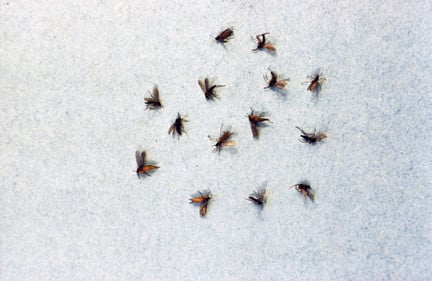
Quick facts
Common name - Fungus gnats or sciarid flies
Scientific names - Bradysia and other species
Plants affected - Seedlings, soft cuttings in greenhouses and pot plants
Main cause - Maggots feeding on decaying organic matter; adult flies can be a nuisance in houses
Timing - All year round on house plants and in greenhouses
What are fungus gnats?
Fungus gnats are small flies in the family Sciaridae, the family is represented by over 250 species in Britain. Many species feed on rotting organic matter and therefore are a part of a healthy balanced ecosystem and are entirely harmless. A few species in the genus Sciara can breed in large numbers in damp composts and may be considered a nuisance, the -dwelling larvae can sometimes damage and cuttings. These insects also occur out of doors where they cause no damage. Cultivated and wild mushrooms can also be affected. There are also many (perhaps 1000's of ) species of small fly that occur in Britain, most of which are a vital part of natural ecosystems and do not damage garden plants.
Symptoms
Adult fungus gnats are dark greyish brown flies that are mostly 3-4 mm long, some species have yellowish adbomens. They can often be seen running over the surface of seed trays and pots, or flying slowly around plants. The larvae are slender whitish maggots, up to 6 mm long, with black heads. Their bodies are semi-transparent and it is often possible to see the dark coloured gut contents. They live in soil or potting . This insect thrives in damp composts containing high levels of organic matter. Potting media formulated for houseplants is the best choice for indoor plants and may help avoid large numbers of fungus gnats.
Adult fungus gnats do not damage plants but they can cause annoyance when they are flying around indoors. The larvae feed mainly on dead roots and other decaying plant material and associated fungal growth. Some species of fungus gnats may also feed on soft plant growth, such as seedling roots and the base of soft cuttings. are unlikely to be damaged by fungus gnat larvae.

Management
Fungus gnats are really only of concern if they are causing damage to or cuttings; are not harmed. Here are some of the steps you can take to manage this insect:
- In the open garden fungus gnats are not a problem and part of a well balanced biodiverse garden ecosystem
- Check indoor plants frequently, ensuring they are not over watered enabling fungus gnats to breed
- Fungus gnats are often more numerous in composts that are constantly wet, allowing to dry can reduce their numbers, provided this does not affect the health of plants. Potting media formulated for houseplants is the best choice for indoor plants
- Try repotting plants into newly purchased compost. Discarding the old compost rather than resusing it, removes existing eggs and larvae. This compost can be added to a compost heap
- If the adult flies are a problem, their numbers can be reduced by placing yellow sticky traps near the plants. These are widely available from garden centres, however, these traps can catch large numbers of non-target invertebrates, including predators
- Biological control can be used. Pathogenic nematodes (Steinernema feltiae), predatory mites (Hypoaspis miles and 'Mighty Mite', Macrocheles robustus) and a predatory rove beetle (Atheta coriaria) are sometimes available by mail order from various biocontrol supply companies. Formulations of nematodes may also be available in some plant centres. These biocontrols are added to the potting compost where they will help control the eggs, larvae and pupal stages of the flies. The nematodes can potentially affect other insects and the predators can feed on invertebrates other than sciarid fly larvae
Downloads
Biological control suppliers (pdf document)
Biology
Fungus gnats can breed all year round in greenhouses and houses. The females deposit eggs in the surface layer of the potting and these hatch within a few days under warm conditions. The larvae feed on fungal growth and decaying plant material but some species can also damage the roots of or tunnel into the base of soft cuttings. When fully fed, the larvae pupate in the soil. During the summer the life cycle can be completed in about a month.









